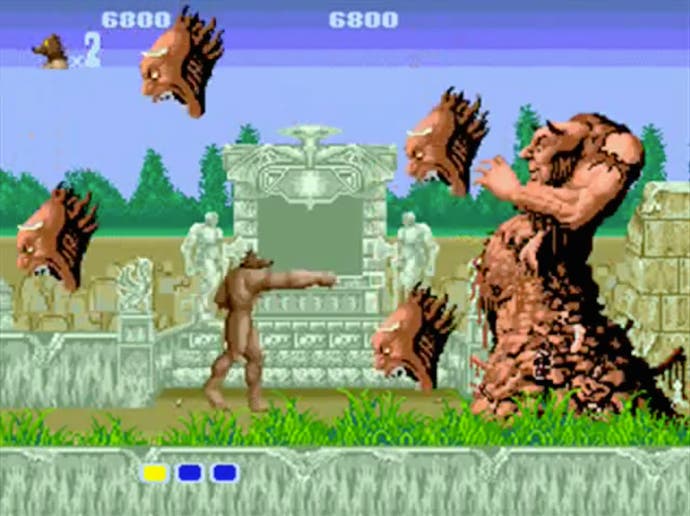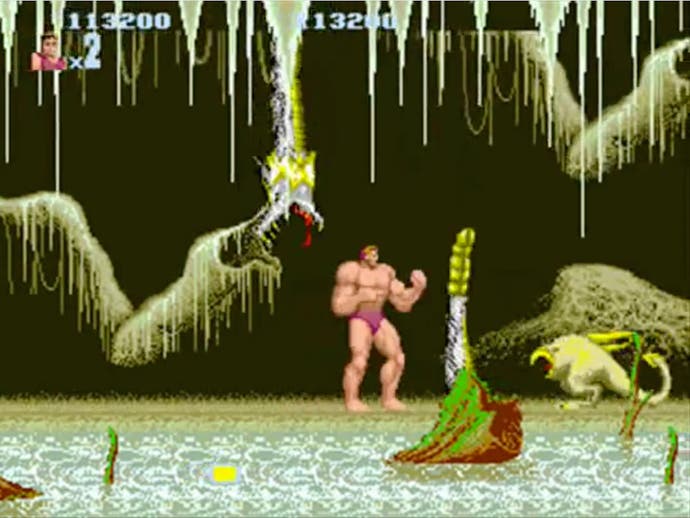Stranger fangs: in defence of Altered Beast
Guess who's bark, bark again.
Every game of Altered Beast - Sega's timeworn, arcade-born bash-em-up of Greek gods and weird monsters - is preceded by a command from Zeus. 'Rise from your grave!' he intones, and with that scratchy incantation of digitised speech, he reanimates a brave, nameless Centurion and throws him into a precarious mission that kicks off immediately with a bloody and slightly disrespectful brawl in a graveyard. The fact that mighty Zeus prefers to delegate the task of rescuing his beloved daughter from the evil sorcerer Neff suggests the randy old goat might know more about the perils of the situation than he is letting on. But despite his powers of resurrection and prophecy, not even Zeus could have predicted the dogged afterlife of Altered Beast, a lycan game that no-one seems to love.
When Sega rolled out Sega Forever, the new umbrella for their existing and future plans to consolidate a hefty back catalogue of classic games for iOS and Android, the inclusion of Altered Beast in the launch line-up was met with either eye-rolling indifference or darkly muttered mentions of silver bullets. Really? Again? (It probably didn't help that Altered Beast has been available for iOS since 2010.) This furry perennial was the packed-in game for the first Genesis and Mega Drive bundles to ship worldwide and that long familiarity seems to have fostered a very particular strain of bland contempt. It was fine, for the time. A necessary stepping stone to get to the good stuff. But yeah, can you believe we used to play that?
That version of Altered Beast - the cartridge bundled in with consoles, the one now available for smartphones and tablets - was always going to start off slightly on the back paw. The original 1988 arcade machine, conceived as a rival to Double Dragon, disguised its rather stodgy gameplay with some CPU razzle-dazzle. As well as the crackly speech ('Welcome to your doom!' was Neff's rival catchphrase) there were other technical curlicues. In the arcade, battering a baddie caused them to burst into bloody chunks that seemed to explode out of the screen in pseudo-3D. And as your Centurion levelled up by absorbing Spirit Balls - the game's essential currency of transmogrification - his punches and kicks generated Last Airbender-style swooshes that were subtly animated to suggest shockwaves of power. These flourishes ended up being just a little cruder when it came to the stepped-down cart.

Cosmetic issues aside, the real issue at the tangled heart of Altered Beast is the frustrating gap between its promise to the player of becoming a wild, uncaged were-monster and the rather more fractious process of achieving it. In each level, three Spirit Balls are required to trigger your transformation from recently revived zombie to superpowered mutant-beast. Even almost three decades on, those rewards remain mouthwatering. Become a fireball-slinging werewolf whose zippy charge attacks scorch a flaming V into the screen! A flying dragon who can generate a Blanka-style electric shock field! A bad news bear with breath that turns enemies to stone! A were-tiger that leaps in vertical pillars of flame! And, in the fifth and final stage, the chance to become a fireball-slinging werewolf again But Gold This Time!
Each level hinges on the player achieving their ultimate atavistic potential, since the evil Neff will hang back for as long as possible until you unleash the beast. But it is this see-saw of difficulty that makes it so hard to squeeze out the fun. You have to be willing to put in an inordinate amount of effort to learn and anticipate the attack patterns of Altered Beast's motley zoo of zombies, minotaurs and weird blobs that attach themselves to your head, while also ensuring you never miss the white Cerberus hellhounds carrying the vital Spirit Balls. Where the game should soar, it becomes a slog. It doesn't help that despite bizarro character designs - from chitinous insect warriors that barge along with rush-hour intensity to turtles that creepily ripple across the screen like cuttlefish on the ocean floor - there is no truly iconic Altered Beast baddie. Look at R-Type's first big boss, a Bydo/Giger techno-organic nightmare that still has the power to inspire both fan-art and nightmares. At the end of Altered Beast's first level, Neff transforms himself into Aggar, a weird scraggly graveyard compost heap that throws lots of heads at you like Worzel Gummidge after too much scrumpy.
Having wrestled with Altered Beast in various versions down the years, I still feel that just the slightest recalibration of its core elements - a slightly more nimble Centurion, a dialling-back of grunt attack patterns, the opportunity to spend more time in beast mode outside of boss encounters, the better to relish your sudden mega-powers - could unlock its potential. Designer Makota Uchida would go on to create Golden Axe and you can detect a vague family resemblance, not least because both games feature oversized two-legged chicken beasts. Sadly Altered Beast's Sega Forever incarnation doesn't show it at its ragged, rampant best. Despite being a side-scrolling brawler that only takes place on one plane, the default touchscreen controls feel too fiddly to effectively navigate its unforgiving gauntlet. It's just a little too hard to reliably jump, punch and do that weird Bikram Yoga move where you lie on your back and kick straight up to deal with divebombing air enemies.

Squinting through a Sega corporate prism, you could easily view Altered Beast's resilience as simply a lack of imagination (it was a launch title last time round, so let's do it again) or a conscious attempt to keep the IP visible (a story did the rounds late last year that a movie was in the works). So does it really deserve a place in the first wave of Sega Forever? When that question was put to Sega by Eurogamer recently, the response was to discuss the game in terms of "historical context" and it feels like a valid point.
We now live in a magical sci-fi nexus where practically the entire continuum of video games is available and it would be a relatively simple operation to discreetly unplug Altered Beast from the Sega's 16-bit foundational myth. You could front-load the Sega Forever initiative with certified best-sellers or hipster-baiting cult hits, airbrushing some of the baby steps out of the picture. But that would be disrespectful to an entire generation whose first glimpse of a 16-bit future was Altered Beast's rolling demo, perhaps witnessed on a shelf in a Comet, or a Currys, or even a Boots.
That attract mode stares right back at you, with giant, looming human-then-lupine eyeballs and a digitised werewolf howl appropriate to herald a new era. It may be an increasingly creaky relic, but it is one crammed with unbridled Doctor Moreau ideas that still seem strange and a little exciting. That's why I came here to praise Altered Beast, not to bury it. And even if Sega did quietly shove Altered Beast into a deep, dark IP oubliette, it feels like it might find some other way to come back. It always does.

